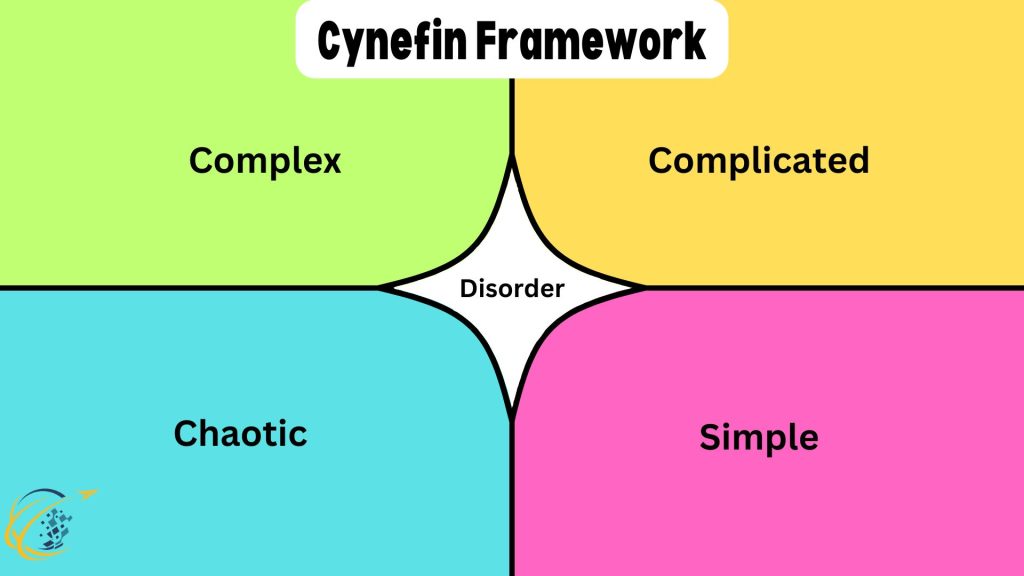 Welcome to an exploration of the Cynefin Framework, a powerful tool designed to enhance decision-making in various business contexts. This framework is crucial for leaders and managers facing decisions in volatile as well as complex environments. Through this guide, you will learn how the Cynefin Framework categorizes problems into distinct domains, each requiring a different approach for effective management. As you explore the nuances of this framework, you’ll gain insights into applying its principles to real-world situations. This will improve your strategic thinking and also response strategies. Whether you are handling daily operations or unforeseen challenges, understanding the Cynefin Framework equips you to tailor your decisions to the complexity of the circumstances you face.
Welcome to an exploration of the Cynefin Framework, a powerful tool designed to enhance decision-making in various business contexts. This framework is crucial for leaders and managers facing decisions in volatile as well as complex environments. Through this guide, you will learn how the Cynefin Framework categorizes problems into distinct domains, each requiring a different approach for effective management. As you explore the nuances of this framework, you’ll gain insights into applying its principles to real-world situations. This will improve your strategic thinking and also response strategies. Whether you are handling daily operations or unforeseen challenges, understanding the Cynefin Framework equips you to tailor your decisions to the complexity of the circumstances you face.
Introduction to the Cynefin Framework
The Cynefin Framework is a decision-making tool that helps leaders understand complex situations to make informed decisions. Developed in 1999 by Dave Snowden at IBM Global Services, it has become a respected approach for navigating unpredictable and dynamic real-world scenarios.
This framework categorizes problems into five domains: Simple, Complicated, Complex, Chaotic, and Disorder. Each domain demands a different response, making this framework a versatile tool for leaders. By recognizing the nature of the situation, leaders can apply the most appropriate strategies. For example, simple and complicated contexts might need straightforward processes or expert advice, while complex and chaotic contexts require innovative and agile responses.
Using the Cynefin Framework helps you clearly perceive the nuances of your environment. This clarity improves strategic planning and effective challenge management by tailoring approaches to specific problems. Thus, you avoid the pitfalls of misreading situations and applying unsuitable one-size-fits-all solutions.
For leaders in rapidly changing and uncertain environments, the Cynefin Framework offers valuable insights. It helps identify problem types and understand the best ways to approach them, increasing the likelihood of successful outcomes.
Understanding the Five Domains
The Cynefin Framework categorizes issues into five distinct domains, each requiring different management approaches and decision-making strategies. Understanding these domains helps you apply the most effective tactics to navigate varying situations.
Simple (Obvious) domain situations are characterized by stable environments where cause and effect are clear. Here, decisions are straightforward, and you can rely on established rules or best practices. The appropriate strategy is to Sense, Categorize, and Respond—meaning you assess the facts, categorize them, and apply the best practice.
Complicated domain scenarios involve a clear relationship between cause and effect, though not immediately evident to everyone. Expert diagnosis is required to understand these relationships. The decision-making process in this domain follows the Analyze, Sense, and Respond pattern, relying heavily on expert knowledge and analysis before forming a response.
Complex domain is where cause and effect can only be perceived in hindsight. In this context, the approach is to Probe, Sense, and Respond. This involves experimenting to see what effects various actions have, and learning from this experimentation to manage how you respond.
Chaotic domain scenarios are turbulent and unpredictable, with no clear cause-and-effect relationships. Immediate action is required to reestablish order. The strategy here is to Act, Sense, and Respond. Leaders must make quick decisions to stabilize the situation and move it to another domain for more detailed analysis.
Disorder is the state of not knowing which of the other four domains applies. In this domain, the immediate focus is to break down the situation into constituent parts and assign each to one of the other four domains. The method is to assess the situation, categorize parts of the problem, then apply the appropriate domain tactics.
Applications in Business
The Cynefin Framework offers a robust methodology for businesses to manage complexities and uncertainties effectively. By categorizing challenges into five distinct domains, businesses can tailor their strategies effectively to match the nature of the challenges they encounter.
For example, in the Simple domain, a fast-food chain might use standard operating procedures for customer service to ensure consistency and efficiency, where cause and effect are clear.
In the Complicated domain, an automotive manufacturer may rely on expert analysis to optimize supply chain logistics. While the processes are complex, experts can discover efficient solutions through thorough analysis.
In the Complex domain, a tech startup in a rapidly changing market might employ iterative development and continuous feedback loops. This allows the company to adapt its product based on real-time user data, recognizing that in complex scenarios, cause and effect are understood in retrospect.
In the Chaotic domain, a business facing a sudden crisis, like a cybersecurity attack, needs immediate action. The first goal is to stabilize the situation and prevent further damage, followed by a detailed assessment once the chaos is under control.
In the Disorder domain, the priority is to determine the actual domain you are dealing with. A multinational company facing multifaceted challenges might need to segment its issues to manage each one effectively.
By applying the Cynefin Framework, businesses not only react adeptly to various situations but also anticipate potential problems before they escalate. This strategic foresight enables companies to turn challenges into opportunities, navigating their industry’s complexities with greater agility and informed confidence.
Leadership and the Cynefin Framework
Leadership effectiveness can be greatly enhanced by the strategic use of the Cynefin Framework, especially in volatile and ambiguous environments. This framework helps leaders diagnose situations accurately and choose the most fitting leadership style and decision-making process.
In simple contexts, where the relationship between cause and effect is clear, leaders can make quick, decisive actions. The leadership approach here focuses on directing and instructing, ensuring established processes are followed for efficiency and predictability.
In complicated scenarios that require expert analysis, leaders should gather insights from knowledgeable team members or external experts. The role of leadership shifts towards facilitating and synthesizing complex information, guiding teams through structured problem-solving methods.
In complex environments, where outcomes are unpredictable, leaders benefit from an exploratory and adaptive approach. This involves testing various strategies, sensing their performance, and responding accordingly. Leaders excel by fostering an environment that encourages innovation and also learning from emergent patterns.
In chaotic contexts, swift and decisive action is crucial, as is recognizing when to switch to more appropriate management strategies after initial stabilization. Leadership in these scenarios involves direct command to stabilize the situation, followed by consultative approaches to manage the aftermath.
The Cynefin Framework encourages leaders to adapt their style to meet the demands of each situation. By understanding and applying this framework, you can enhance your responsiveness, improve decision-making, as well as increase your effectiveness as a leader in dynamic and uncertain environments.
Strategic Planning and Risk Management
Integrating the Cynefin Framework into strategic planning and risk management significantly enhances an organization’s ability to manage uncertainty. This framework provides a structured method to assess and respond to complexities, which is crucial in today’s dynamic business environment.
In strategic planning, the Cynefin Framework helps classify challenges into one of five contexts—Simple, Complicated, Complex, Chaotic, and Disorder. Each context requires a distinct approach. For Simple and Complicated contexts, where outcomes are more predictable, applying best practices and expert knowledge optimizes efficiency.
In Complex and Chaotic scenarios, where outcomes are less predictable, the framework recommends flexibility and adaptability. Strategic plans should include experimentation to explore various possibilities and learn from the results. This adaptive approach helps manage risks by quickly responding to changes.
For risk management, the Cynefin Framework helps categorize risks by the context in which they arise, guiding the application of appropriate mitigation strategies. In Complex scenarios, instead of attempting to control all variables, the focus shifts to building resilience and also adapting to emerging patterns. In Chaotic situations, the immediate goal is to stabilize the environment before reassessing strategies.
By applying the Cynefin Framework, you can make strategic planning and risk management more context-sensitive, improving your ability to navigate complex situations. This method not only aids in managing current challenges but also prepares you to capitalize on opportunities as well as minimize risks as they emerge.
Challenges and Limitations
The Cynefin Framework offers valuable insights for managing diverse business scenarios, yet its implementation comes with notable challenges and limitations.
One major challenge is the misclassification of situations, where misjudging a Complicated situation as Complex can result in overconfidence and underestimation of variability and emergent issues. To counter this, teams must deeply understand the framework and regularly engage in training and discussions to hone their judgment.
The framework guides responses instead of providing specific solutions, which can be problematic for users seeking direct answers. To remedy this, combine the framework with other decision-making tools that provide detailed guidance for complex scenarios.
The dynamic nature of business can also cause rapid shifts from one domain to another, necessitating quick reassessment and adaptation. This fluidity can be disorienting, leading businesses to revert to ineffective conventional strategies. Incorporating flexibility into strategic planning and also fostering a culture that embraces change can mitigate this risk.
Additionally, there’s a risk of overcomplication when trying to categorize every problem strictly within the four domains. Focusing on the framework’s principles over rigid categorization can prevent analysis paralysis.
By recognizing and preparing for these challenges, you can effectively utilize the Cynefin Framework to improve decision-making as well as strategic thinking in your organization.
Conclusion
In conclusion, the Cynefin Framework provides a robust lens for navigating modern business complexities. By understanding and using this framework, you can diagnose situations more accurately and respond effectively. This enhances your decision-making processes. Though there are challenges and limitations to its use, these can be managed through adequate training, flexibility, and also strategic integration. As you move forward, the key to effectively leveraging the Cynefin Framework lies in your adaptability. Embrace this framework as part of your strategic toolkit to improve leadership, enhance problem-solving, as well as drive your organization toward sustainable success.


